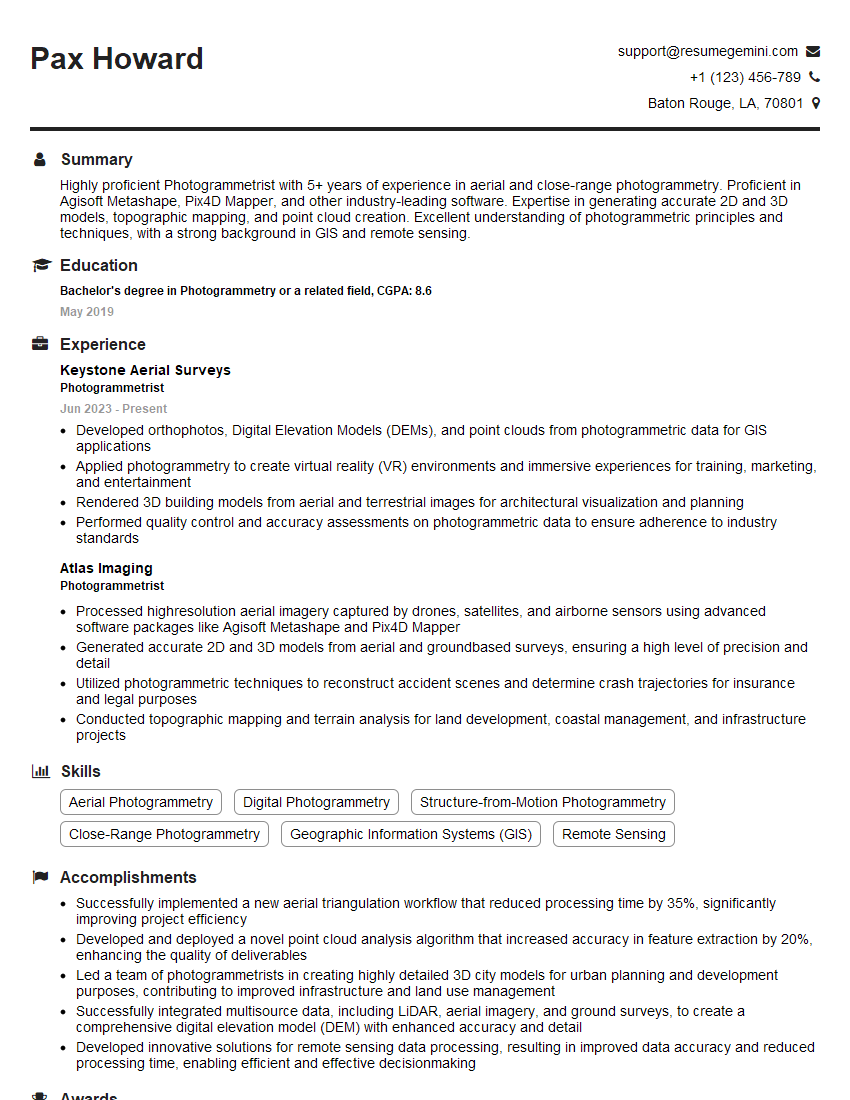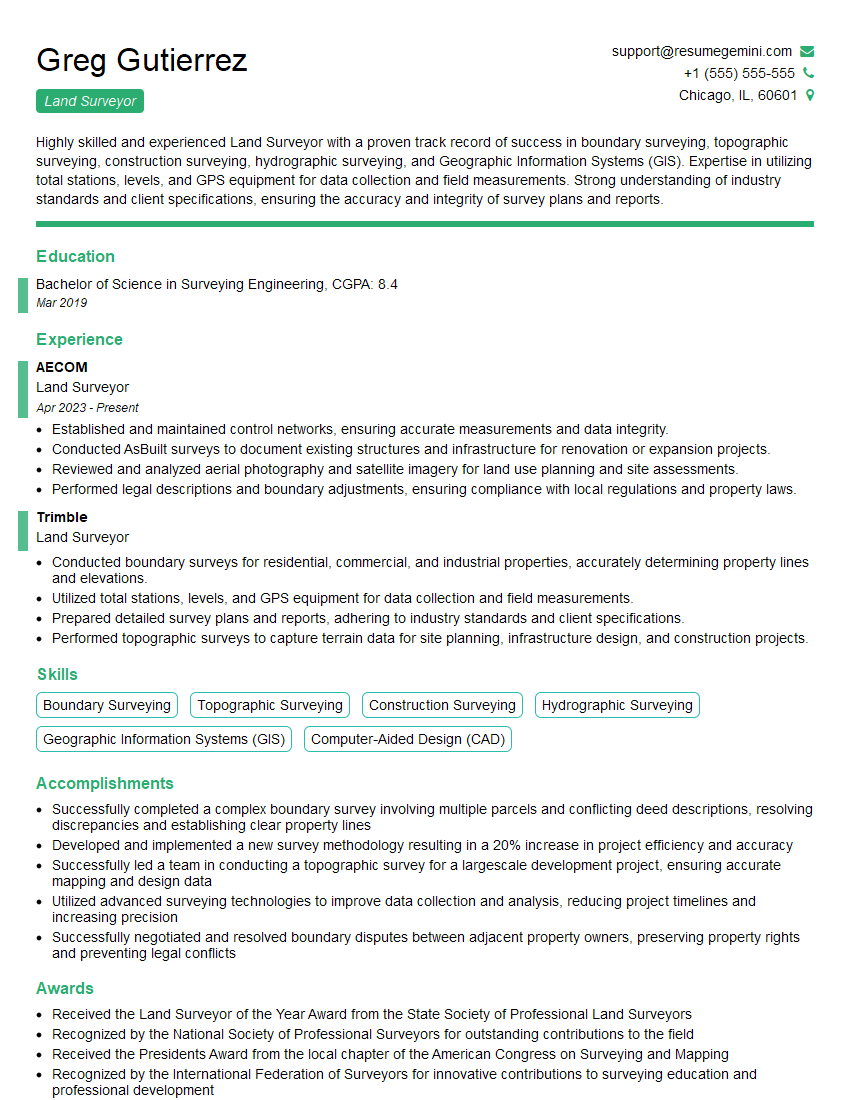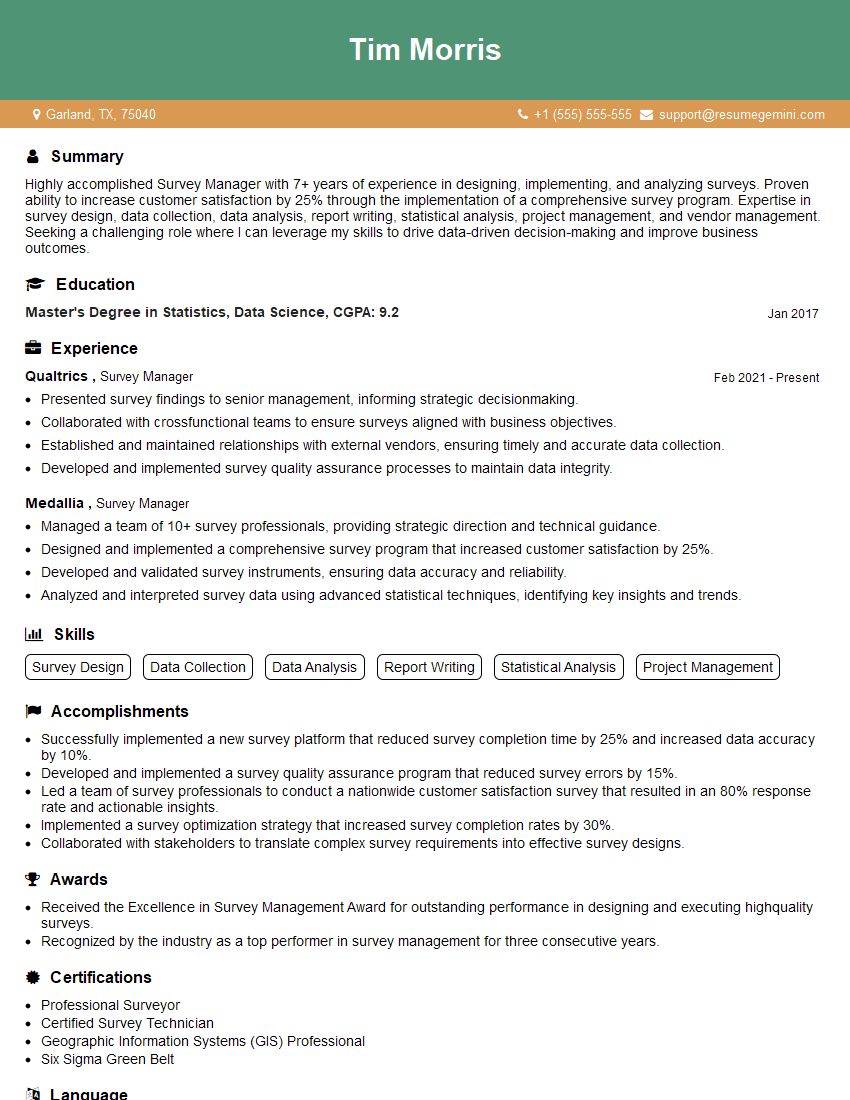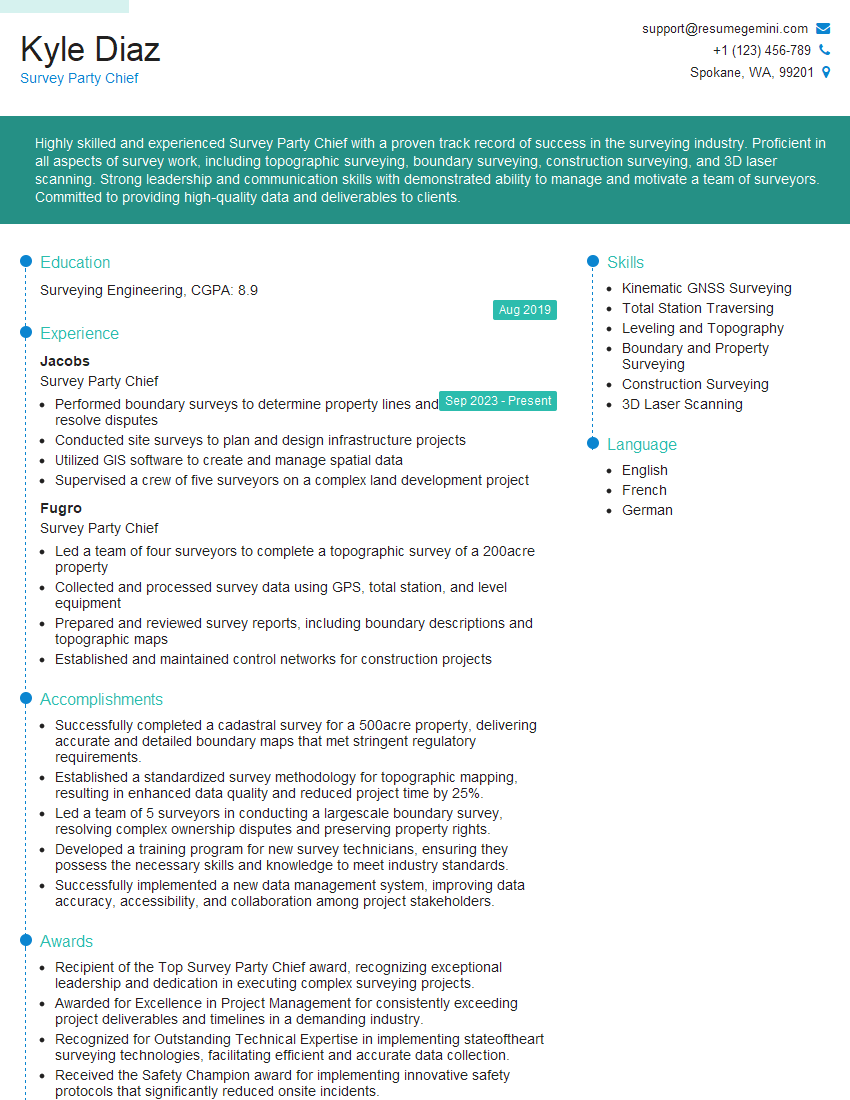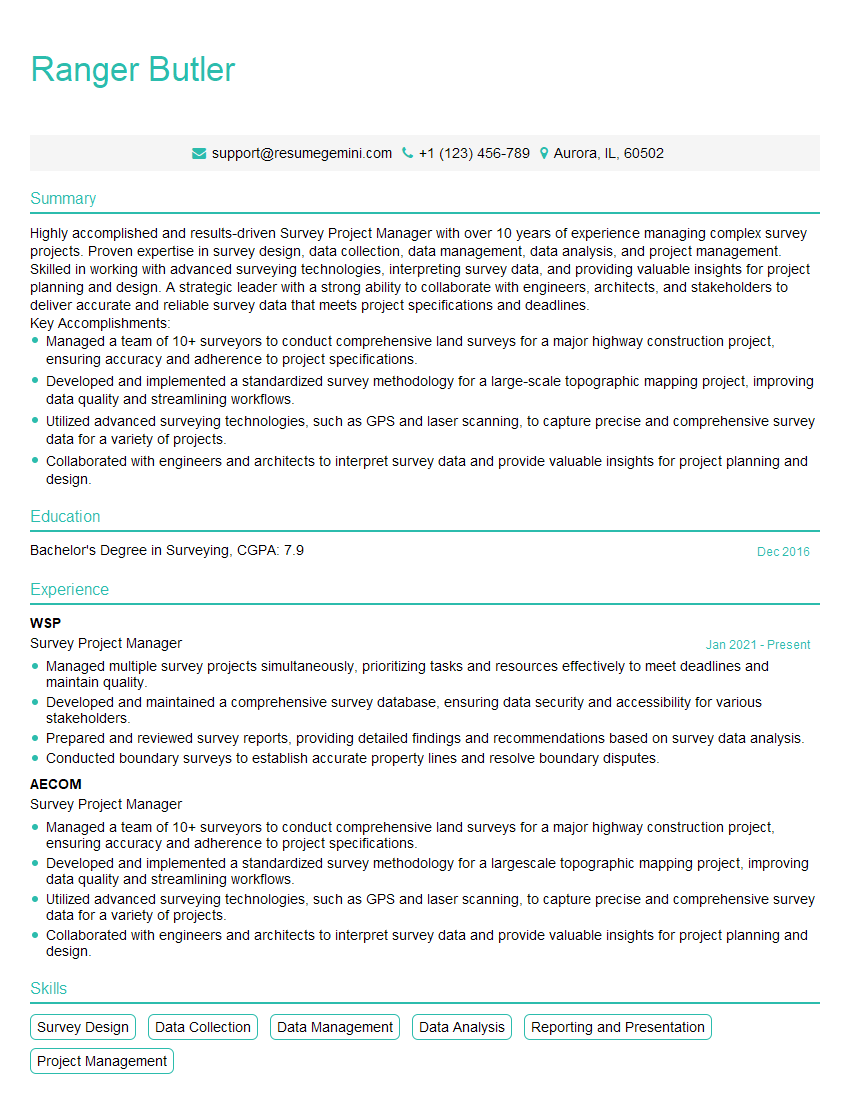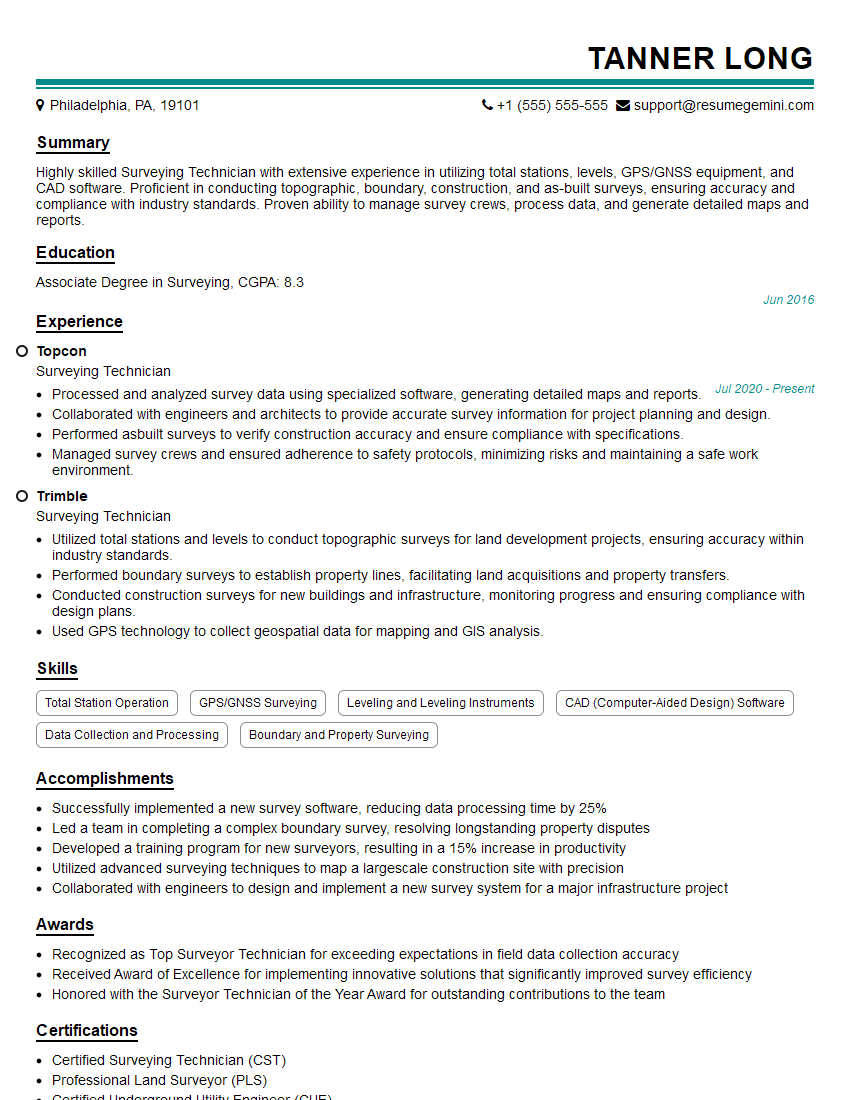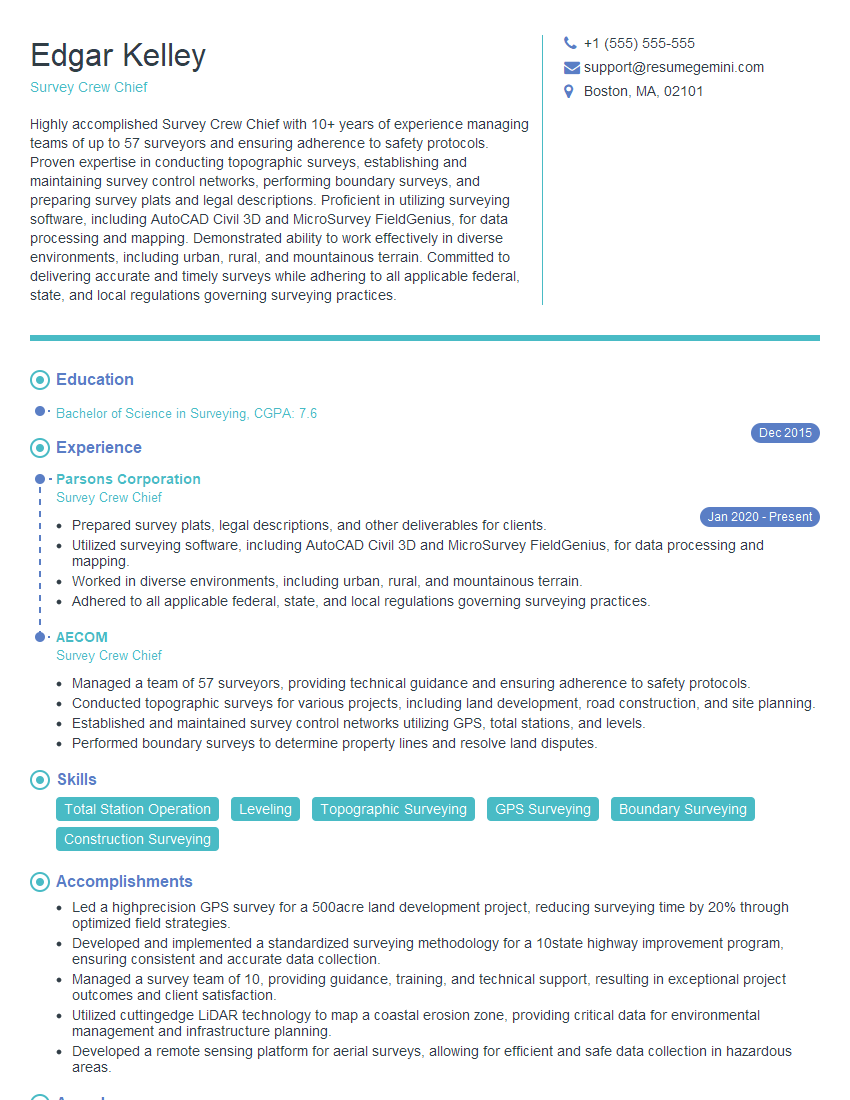Unlock your full potential by mastering the most common Knowledge of surveying codes and regulations interview questions. This blog offers a deep dive into the critical topics, ensuring you’re not only prepared to answer but to excel. With these insights, you’ll approach your interview with clarity and confidence.
Questions Asked in Knowledge of surveying codes and regulations Interview
Q 1. What are the key differences between the National Geodetic Survey (NGS) and state plane coordinate systems?
The National Geodetic Survey (NGS) and state plane coordinate systems are both crucial for defining locations on the Earth’s surface, but they operate at different scales and with different projections. The NGS is a national system using a geodetic datum (like NAD83) which is a precisely defined reference ellipsoid approximating the Earth’s shape. Coordinates in the NGS system are geodetic latitude, longitude, and elevation. Think of it as the ‘big picture’ – a nationwide, highly accurate framework.
State plane coordinate systems, on the other hand, are designed for smaller areas within a state. They use different map projections (like the Transverse Mercator or Lambert Conformal Conic) to minimize distortion within their smaller zones. These projections convert geodetic coordinates into plane coordinates (easting and northing), making them easier to use for local surveying and mapping projects. They are essentially localized versions of the larger NGS system, optimized for practical applications within a state’s boundaries. Imagine zooming in from a satellite image of the whole country to a detailed map of your city – that’s the difference in scale and purpose.
In essence, NGS provides the fundamental framework, while state plane coordinates offer a more practical, locally accurate coordinate system for everyday surveying work.
Q 2. Explain the importance of boundary surveys in land ownership disputes.
Boundary surveys are critically important in resolving land ownership disputes because they precisely define the legal boundaries of a property. These surveys use historical records, physical evidence (like monuments and fences), and sophisticated measurement techniques to establish the exact location of property lines. When disputes arise, a properly conducted boundary survey acts as the definitive evidence in determining where the property boundaries actually lie. It’s like a legal referee, providing objective data to resolve conflicting claims.
For example, a disagreement over the location of a fence line between neighbors might be resolved by a boundary survey. The surveyor will examine deeds, examine the existing physical evidence, and potentially conduct new measurements to determine the legally defined boundary, thereby clarifying ownership rights. Without a clear boundary survey, disputes can escalate into lengthy and costly legal battles.
Q 3. Describe your experience with various surveying instruments (e.g., total stations, GPS receivers).
Throughout my career, I’ve extensively used various surveying instruments, mastering their capabilities and limitations. Total stations are workhorses for precise distance, angle, and elevation measurements. I’m proficient in operating them, including setting up, aiming, performing measurements, and data logging. I’ve used them in projects ranging from small-scale building site surveys to large-scale road alignment projects.
GPS receivers are essential for geodetic control and positioning. I have experience with both real-time kinematic (RTK) and post-processed kinematic (PPK) GPS techniques, utilizing different types of receivers depending on project requirements and the desired level of accuracy. RTK offers real-time centimeter-level accuracy, ideal for projects requiring immediate positional information, while PPK provides even higher accuracy after post-processing, essential for high-precision surveys.
In addition to total stations and GPS, I am familiar with other equipment such as levels, theodolites, and EDM (electronic distance measurement) instruments. This diverse experience ensures I can select the optimal instrumentation for various surveying tasks, maximizing accuracy and efficiency.
Q 4. How do you ensure accuracy and precision in your surveying measurements?
Ensuring accuracy and precision in surveying measurements is paramount. My approach is multi-faceted and involves meticulous planning, careful execution, and rigorous quality control. I begin with thorough site reconnaissance to identify potential challenges and plan measurement strategies accordingly. Then, I employ proper instrument calibration and maintenance procedures to ensure equipment is functioning optimally. During data collection, I follow established procedures such as multiple measurements, redundancy, and appropriate checks to minimize errors.
After data collection, rigorous quality control procedures are essential. This involves data validation to check for inconsistencies or outliers, applying appropriate error corrections, and performing coordinate transformations as needed. Finally, I use statistical analysis to assess the overall accuracy and precision of the results, ensuring they meet the project’s requirements. A good surveyor is always thinking about how to minimize errors at each stage of the process.
Q 5. What are the common surveying codes and regulations you have worked with?
My work has involved adherence to various surveying codes and regulations, including but not limited to the American Land Title Association (ALTA) standards for boundary surveys, relevant state licensing board regulations, and local ordinances governing land development and construction. I’m particularly familiar with the standards for accuracy in boundary surveys, ensuring that property lines are established with the highest possible degree of precision to avoid future disputes. My experience encompasses the specific requirements for different types of surveys such as topographic surveys, construction surveys, and as-built surveys, ensuring each project meets all applicable regulatory standards. This experience has made me an expert at managing regulatory requirements and successfully delivering compliant survey products.
Q 6. Describe your experience with data processing and analysis in surveying projects.
Data processing and analysis are integral parts of any surveying project. I’m proficient in using various software packages (e.g., AutoCAD Civil 3D, MicroStation, and specialized surveying software) to process raw survey data. This involves coordinate transformations, error analysis, data adjustment techniques, and the generation of various deliverables such as maps, drawings, and digital terrain models (DTMs). My expertise extends to applying advanced surveying techniques such as least squares adjustment to ensure the best possible accuracy. I can visualize and analyze data effectively, interpreting it to provide clients with meaningful insights and support sound decision-making.
For example, in a recent project, I used a least squares adjustment to minimize errors and improve the accuracy of a complex network of survey points. The software allowed me to identify and correct any discrepancies before generating the final deliverables. This ensured the quality of the survey data and the client’s satisfaction.
Q 7. How do you handle discrepancies or errors discovered during a survey?
Discrepancies or errors are inevitable in surveying, but how they’re handled is crucial. My approach involves a systematic investigation to pinpoint the source of the error. I start by reviewing the field notes, checking instrument settings, and re-examining the data processing steps. Depending on the nature of the discrepancy, I may re-measure certain sections or consult historical data to validate existing information. If the error is significant, I will investigate and address the root cause before making any corrections. Transparency is vital; I will fully document my investigation and any corrections made to ensure the integrity of the final results. In cases where resolution requires input from others, such as consulting with property owners or other surveyors, I will work collaboratively to arrive at an agreed upon solution.
Q 8. Explain the legal aspects of surveying, particularly concerning property boundaries.
The legal aspects of surveying, especially concerning property boundaries, are crucial and complex. They center around the principle that accurate boundary determination is essential for resolving land ownership disputes and ensuring fair transactions. Surveys are often legal documents themselves, admissible as evidence in court.
For example, a boundary survey needs to meticulously follow state-specific guidelines and utilize accepted surveying techniques. Errors in a survey can lead to legal challenges, potentially resulting in costly boundary disputes. A surveyor needs to understand and apply relevant statutes, case law, and local regulations regarding property lines, easements, and encroachments. Understanding deed descriptions and their interpretations is also paramount. A professional surveyor’s work in this area is to create a boundary survey that is legally defensible and accurate, thereby mitigating potential legal risks for their clients.
In practice, this involves carefully reviewing title records, identifying existing monuments (markers indicating property corners), performing on-site measurements, and creating a legal description of the property boundaries. The resulting survey plan should clearly and unambiguously depict the boundary location, including any easements or encroachments. Any discrepancies between the deed and the physical evidence on the ground need to be documented and explained.
Q 9. How do you comply with OSHA safety regulations on surveying sites?
OSHA safety regulations are paramount on any surveying site. My approach focuses on proactive hazard identification and mitigation. This begins with a thorough site assessment before commencing fieldwork, identifying potential hazards such as uneven terrain, excavation sites, traffic, electrical lines, and hazardous materials. A comprehensive safety plan is then developed and communicated to the entire surveying crew.
This plan covers personal protective equipment (PPE) usage, including hard hats, safety glasses, high-visibility clothing, and appropriate footwear. We strictly adhere to safe operating procedures for all equipment, from total stations to GPS receivers, ensuring regular maintenance and calibration. We emphasize safe working practices, especially when working near roads, construction zones, or bodies of water.
Training is crucial. All team members are regularly trained on OSHA safety standards and emergency procedures. Regular toolbox talks address specific site hazards and reinforce safety protocols. In situations involving potentially hazardous conditions, like working near underground utilities, we always contact the relevant utility companies for assistance and engage in safe excavation practices.
Q 10. What are your experiences with different types of surveys (e.g., topographic, boundary, construction)?
My experience encompasses a wide range of surveying types. I’ve extensively worked on topographic surveys, producing detailed maps of terrain features for various applications, including construction planning, environmental impact assessments, and land development. This involves using GPS, total stations, and level instruments to gather elevation and positional data.
Boundary surveys, as discussed earlier, are a critical part of my practice. I have significant experience in determining and marking property lines, resolving boundary disputes, and preparing legal descriptions for property transactions. Construction surveys are another area of my expertise, where I provide accurate measurements and set-out points for construction projects, ensuring buildings and infrastructure are built according to the design plans. This involves stakeout, monitoring construction progress, and ensuring compliance with specifications.
I’ve also undertaken other types of surveys, such as as-built surveys (documenting completed construction), route surveys (for transportation projects), and hydrographic surveys (mapping underwater features). The common thread across all these is a meticulous approach to data collection, processing, and analysis, ensuring accuracy and adherence to professional standards.
Q 11. How familiar are you with various mapping software and applications?
I’m proficient in various mapping software and applications. My experience includes using industry-standard software like ArcGIS, AutoCAD Map 3D, and QGIS for tasks such as data management, spatial analysis, map creation, and presentation. I’m comfortable with GPS data processing software like Leica Geo Office and Trimble Business Center, which are essential for handling and adjusting data from GPS surveys.
Beyond this, I’m also familiar with cloud-based mapping platforms, and I have experience utilizing various mobile mapping apps for field data collection. This ensures flexibility and efficient workflows, allowing for seamless integration of data from different sources. My skillset allows me to select the appropriate software for a given project, optimizing workflow and results.
Q 12. Describe your proficiency in using CAD software for surveying data representation.
My CAD proficiency extends beyond basic drafting. I use CAD software, primarily AutoCAD Civil 3D, extensively for creating and managing surveying data. This includes creating detailed plan and profile drawings, generating cross-sections, and performing volumetric calculations. I’m adept at importing and exporting data in various formats (e.g., DXF, DWG, LandXML), ensuring seamless integration with other software and workflows.
Beyond visualization, I leverage CAD’s capabilities for precise calculations and analysis. For example, I use CAD to create detailed design plans, perform stakeout calculations, and create 3D models for visualizing complex projects. My proficiency ensures that the final output is accurate, visually appealing, and easily understood by clients and other stakeholders. I am also familiar with MicroStation, which is another commonly used CAD software in the industry.
Q 13. Explain the concept of least squares adjustment in surveying data processing.
Least squares adjustment is a fundamental method in surveying data processing used to reconcile discrepancies between measured data and a mathematically consistent model. Think of it as finding the ‘best fit’ solution, minimizing the overall error in measurements. It’s based on the principle of minimizing the sum of the squares of the residuals (the differences between observed and computed values). This approach accounts for the fact that all measurements contain errors. By using mathematical algorithms, we find the most probable values for the unknown parameters (e.g., coordinates of points), based on the measured data.
In practice, a least squares adjustment uses matrices to solve a system of equations, minimizing the overall error. Software packages automate this complex process. The outcome is a set of adjusted coordinates and other parameters that are more accurate and consistent than the raw measurements. This process ensures the integrity and reliability of the survey data and the resulting maps.
For instance, in a traverse survey (a series of connected lines), small measurement errors accumulate. A least squares adjustment compensates for this, providing a more accurate representation of the surveyed area. The method accounts for the different precision of measurements (e.g., some measurements might be more accurate than others), yielding more reliable results.
Q 14. How do you handle adverse weather conditions during fieldwork?
Adverse weather conditions pose significant challenges in fieldwork, demanding careful planning and flexible execution. Safety is the utmost priority. High winds, heavy rain, or snow can render some surveying techniques unsafe or impractical. For example, using a total station in high winds could lead to inaccurate measurements, while heavy rain can damage equipment.
My approach is to constantly monitor weather forecasts and adjust the fieldwork schedule accordingly. We postpone fieldwork when severe weather conditions are expected. If fieldwork is unavoidable despite adverse weather, we take appropriate precautions. This includes using weatherproof equipment, adjusting survey techniques where necessary, and prioritizing the safety of the crew. We might modify our workflow to prioritize tasks that are less susceptible to weather interference. We also maintain clear communication with the client, keeping them updated on any delays due to weather.
Equipment protection is crucial. We ensure all equipment is properly stored and protected from rain or moisture. In cold weather, we need to consider potential impacts on equipment performance and crew well-being. The key is preparedness, flexibility, and prioritization of safety.
Q 15. Describe your experience with GPS surveying techniques, including RTK and post-processing.
GPS surveying is a cornerstone of modern surveying, significantly increasing efficiency and accuracy. Real-Time Kinematic (RTK) GPS involves using two GPS receivers: a base station at a known location and a rover in the field. The base station transmits corrections to the rover in real-time, allowing for centimeter-level accuracy. This is ideal for tasks requiring immediate positional information, like setting out points for construction. Post-processing, on the other hand, involves collecting data from multiple receivers over a period, then using specialized software to process this data and correct for atmospheric delays and other errors. This method offers even higher accuracy, sometimes reaching millimeter levels, but requires more time and specialized software.
My experience encompasses both techniques. I’ve extensively used RTK GPS for setting out building foundations, utilities, and monitoring construction progress. For projects demanding the highest accuracy, such as cadastral surveys or precise engineering measurements, I’ve relied on post-processed GPS data, leveraging software like RTKLIB or Bernese GNSS Software to achieve the necessary precision. I am proficient in various GPS receiver brands and data formats, ensuring data compatibility across projects.
Career Expert Tips:
- Ace those interviews! Prepare effectively by reviewing the Top 50 Most Common Interview Questions on ResumeGemini.
- Navigate your job search with confidence! Explore a wide range of Career Tips on ResumeGemini. Learn about common challenges and recommendations to overcome them.
- Craft the perfect resume! Master the Art of Resume Writing with ResumeGemini’s guide. Showcase your unique qualifications and achievements effectively.
- Don’t miss out on holiday savings! Build your dream resume with ResumeGemini’s ATS optimized templates.
Q 16. What are your methods for quality control and quality assurance in surveying?
Quality control (QC) and quality assurance (QA) are paramount in surveying to ensure data reliability and project success. My QC methods involve continuous monitoring during data acquisition, including checking for signal obstructions, multipath effects, and cycle slips. Regular instrument calibration and maintenance are crucial. I also meticulously check data for outliers and inconsistencies using statistical analysis. QA procedures include independent checks of calculations, reviewing data processing steps, and comparing results against existing data or project specifications. For example, I might compare GPS measurements with total station measurements for cross-verification on a large-scale project. I maintain detailed logs of all QC and QA checks, which are vital for demonstrating the accuracy and reliability of the survey data and meeting the required standards. Documentation is key, and I always ensure our procedures align with industry best practices and relevant codes.
Q 17. Explain your understanding of survey control networks and their establishment.
Survey control networks are fundamental to any large-scale surveying project. They form the backbone of the survey, providing a framework of accurately known points to which all other measurements are referenced. These networks are established using high-precision techniques like GPS, total stations, and leveling. The process involves strategically selecting control points, considering factors like visibility, accessibility, and stability. Then, using appropriate instrumentation, the precise coordinates of these points are determined. The network is designed to be robust, minimizing the impact of errors on individual measurements. This often involves employing redundancy – more points than strictly necessary – to allow for error detection and adjustment. Finally, the network is adjusted using least-squares adjustment methods, ensuring the best possible fit to the observed data. A well-designed control network minimizes propagation of errors and ensures the accuracy of all subsequent surveys tied to it. Imagine a spiderweb: the control points are the key junctions, and the rest of the survey measurements are like the threads, all anchored to these stable points.
Q 18. How do you ensure the legal admissibility of your survey data in court?
Legal admissibility of survey data in court requires meticulous attention to detail and adherence to established best practices. This begins with following all relevant legal and regulatory requirements during the survey. This includes proper licensing, accurate record-keeping, and the use of calibrated and regularly maintained equipment. Each step of the survey process, from data acquisition to report generation, must be fully documented. This documentation includes field notes, instrument calibration certificates, data processing logs, and chain of custody for all evidence. I ensure my work meets the standards outlined in relevant professional codes of conduct and follows any specific requirements outlined by the court or legal representatives. My reports are clear, concise, and unambiguous, avoiding any technical jargon that could be misinterpreted. Presenting clear and accurate evidence is critical in building a reliable and defensible case.
Q 19. What are the common sources of error in surveying, and how do you mitigate them?
Numerous sources of error can affect survey accuracy. Instrumental errors stem from imperfections in the equipment, such as miscalibration of total stations or GPS receiver malfunction. Environmental factors, such as atmospheric refraction (affecting both optical and GPS measurements) and temperature variations, also introduce errors. Human errors, like incorrect reading of instruments or inaccurate recording of measurements, are another common source of issues. Systematic errors are consistent and repeatable, while random errors are unpredictable. Mitigation involves careful instrument calibration, utilizing appropriate environmental corrections (e.g., atmospheric correction models for GPS), employing robust data processing techniques, and implementing thorough quality control measures at every stage. For instance, conducting multiple measurements and averaging results helps minimize random errors. Employing redundancy in control networks mitigates the impact of systematic errors.
Q 20. Describe your experience with the different types of survey markers and their significance.
Survey markers are crucial for preserving the results of surveys over time. Different types of markers serve different purposes. Permanent markers, such as concrete monuments or steel rods, are designed for long-term stability and are commonly used for cadastral surveys or control points. Temporary markers, like wooden stakes or painted marks, are suitable for short-term use during construction or other temporary surveys. The significance lies in their ability to provide a physical reference point on the ground, allowing for future resurveys and verifying the accuracy of past work. I have experience with a variety of markers, including those that meet specific standards, such as those set by the relevant government agencies, ensuring their durability and long-term viability. The choice of marker depends on the project’s longevity, the required accuracy, and environmental factors. For example, in an area prone to flooding, a deeply buried concrete monument would be preferred over a surface marker.
Q 21. Explain the process of preparing a survey report, including appropriate documentation.
Preparing a survey report requires careful organization and attention to detail. The report should clearly state the project’s objective, the methodology used, the data acquired, and the analysis performed. It typically includes a title page, table of contents, introduction, survey methodology section, data presentation (often with tables, diagrams, and maps), analysis and interpretation of the results, conclusions, and recommendations. All data should be clearly labeled and referenced to ensure traceability. Appropriate documentation includes field notes, data sheets, instrument calibration certificates, and copies of relevant permits or approvals. The report should adhere to relevant standards and be written in a clear and concise style, avoiding technical jargon where possible. A well-structured survey report serves as a permanent record of the survey work and is crucial for legal and regulatory compliance. Consider it the final product that communicates your findings accurately and professionally.
Q 22. How do you interpret and apply relevant surveying standards and specifications?
Interpreting and applying surveying standards and specifications is crucial for ensuring accuracy, consistency, and legal compliance in any surveying project. This involves a thorough understanding of documents like the American Society of Civil Engineers (ASCE) standards, local building codes, and any project-specific requirements. I begin by carefully reviewing all relevant documentation to identify the specific standards applicable to the project’s nature, location, and purpose. For example, a boundary survey will have different standards than a topographic survey. This includes examining things like acceptable tolerances for measurements (e.g., horizontal and vertical accuracy), data collection methods, and data reporting formats.
Once the applicable standards are identified, I incorporate them into every stage of the surveying process. This might involve selecting appropriate equipment (e.g., using a higher-accuracy GPS receiver for a precise survey), employing specific data processing techniques, and adhering to strict quality control procedures. A crucial part of this is documenting every step meticulously, ensuring that the final deliverables comply perfectly with the specified standards. Failure to do so could result in project delays, legal disputes, and compromised safety. I regularly consult updated versions of relevant standards to maintain my expertise and ensure compliance with the latest best practices.
Q 23. Describe your experience with using and maintaining surveying equipment.
My experience with surveying equipment spans a wide range of technologies, from traditional total stations and levels to modern GPS receivers and robotic systems. I’m proficient in operating, maintaining, and troubleshooting these devices. For instance, I’ve extensively used Trimble total stations, performing calibrations and ensuring their optimal performance through regular maintenance checks, including cleaning the optics and verifying the accuracy of measurements. I’m also experienced in using Leica GPS receivers, understanding the nuances of RTK (Real-Time Kinematic) and post-processed kinematic (PPK) techniques to achieve centimeter-level accuracy.
Maintaining surveying equipment involves more than just cleaning; it includes proper storage, regular calibration, and understanding the limitations of each instrument. I follow a strict maintenance schedule for all equipment, including documenting calibration results, performing routine checks of batteries and other components, and performing minor repairs when necessary. Understanding the principles of instrument error is paramount; this knowledge helps in identifying potential problems early and mitigating any impact on data quality. For example, I know how temperature fluctuations can affect the accuracy of electronic distance measurements (EDM) and adjust my work accordingly.
Q 24. Explain your understanding of horizontal and vertical datums.
Horizontal and vertical datums are fundamental reference systems used in surveying to define the location of points on the Earth’s surface. A horizontal datum is a reference surface to which horizontal positions (latitude and longitude) are referenced. Think of it as a mathematical model of the Earth’s shape. Common examples include NAD83 (North American Datum of 1983) and WGS84 (World Geodetic System 1984). The choice of datum depends on the project’s location and requirements. For example, a project in the United States would typically use NAD83, while global projects might utilize WGS84.
A vertical datum, on the other hand, defines the elevation or height of points. It’s a reference surface, usually the mean sea level, from which elevations are measured. In the US, NAVD88 (North American Vertical Datum of 1988) is a commonly used vertical datum. The difference between datums is significant because using inconsistent datums can lead to errors in calculations and positional inconsistencies between different surveys. For instance, using a different horizontal datum can lead to discrepancies in boundary line locations. Therefore, understanding and consistently applying the appropriate datums throughout a project is critical for accuracy and compatibility.
Q 25. How familiar are you with the principles of photogrammetry and its application in surveying?
Photogrammetry is the science of making measurements from photographs. In surveying, it’s a powerful tool for creating accurate maps and 3D models from overlapping aerial or terrestrial images. My familiarity with photogrammetry includes understanding the principles of image acquisition, orientation, and processing. This involves using specialized software to process the images, creating point clouds, and generating orthomosaics and digital elevation models (DEMs). Orthomosaics are georeferenced mosaics of images with minimal geometric distortion, while DEMs depict the elevation of the terrain.
I’ve used photogrammetry in several projects, including creating topographic maps for construction sites and documenting the condition of bridges and infrastructure. The process typically starts with capturing images using drones or specialized cameras, ensuring sufficient overlap between images for accurate 3D reconstruction. Then, the images are processed using software like Agisoft Metashape or Pix4D. The resulting outputs are highly detailed and provide invaluable data for planning, design, and analysis. Photogrammetry’s advantage lies in its speed and ability to cover large areas efficiently compared to traditional ground surveying methods.
Q 26. Describe your understanding of LiDAR technology and its use in surveying projects.
LiDAR (Light Detection and Ranging) is a remote sensing technology that uses laser pulses to measure distances to the Earth’s surface. It’s extremely valuable in surveying because it provides highly accurate and detailed 3D point cloud data. This data can be used to create highly accurate topographic models, identify vegetation and other features, and support various applications. My understanding of LiDAR encompasses the entire workflow, from data acquisition to post-processing.
I’m familiar with different types of LiDAR systems, including airborne and terrestrial. Airborne LiDAR is used for large-scale surveys, while terrestrial LiDAR is employed for smaller, more detailed projects. The data obtained needs post-processing to remove noise, classify points (e.g., ground, vegetation, buildings), and generate various deliverables like DEMs, point clouds, and 3D models. Software like LAStools and ArcGIS are frequently used for this purpose. I’ve used LiDAR data to create highly accurate topographic surveys for infrastructure projects, environmental assessments, and volume calculations in earthworks.
Q 27. What are your methods for managing and organizing surveying data effectively?
Effective management and organization of surveying data are crucial for project success. My approach involves using a combination of established techniques and modern technology. I always begin with a well-defined data naming convention to ensure consistency and easy retrieval. This includes clearly identifying the project, date, and data type. For instance, I might use a naming convention like Project_Name_Date_DataType.ext.
I utilize Geographic Information Systems (GIS) software such as ArcGIS for managing and analyzing geospatial data. This allows for easy visualization, spatial analysis, and integration with other datasets. Cloud-based storage solutions, like Google Drive or similar services, are used to ensure data backup and collaboration. Version control is important, and I ensure that all data versions are properly documented and archived. Metadata is meticulously recorded, describing the data source, acquisition methods, and any relevant processing steps. This careful approach minimizes the risk of data loss or inconsistency and promotes seamless data sharing and collaboration within the project team.
Q 28. How do you communicate technical information effectively to non-technical audiences?
Communicating technical information effectively to non-technical audiences is a vital skill for a surveyor. My approach is to translate complex technical concepts into easily understood language, avoiding jargon whenever possible. I use visual aids like maps, diagrams, and 3D models to illustrate key points and make the information more accessible. For example, instead of discussing coordinate systems, I’d show how they relate to real-world locations on a map.
Analogies and real-world examples are crucial in helping non-technical audiences grasp complex ideas. Explaining survey accuracy using everyday examples, like measuring the length of a room, helps build understanding. I also tailor my communication style to the audience, considering their level of understanding and their specific interests. Active listening is essential; understanding the audience’s questions and concerns allows for more effective communication and ensures that the information is received and understood correctly. Finally, I always provide concise summaries to reinforce key takeaways.
Key Topics to Learn for Knowledge of Surveying Codes and Regulations Interview
- Fundamental Surveying Principles: Understanding the basic concepts of surveying, including measurement techniques, coordinate systems, and error analysis. This forms the bedrock of your knowledge and will be essential for demonstrating a solid foundation.
- Legal Aspects of Surveying: Familiarize yourself with relevant land ownership laws, boundary disputes, and legal descriptions. Knowing how these relate to survey practices is crucial for practical application.
- Specific Surveying Codes and Regulations (Local & National): Research and understand the specific codes and regulations relevant to your geographic area and the type of surveying you’re interested in. This shows you’re prepared for the practical realities of the job.
- Data Acquisition and Processing: Gain proficiency in using surveying instruments and software for data collection, processing, and analysis. Be ready to discuss specific software or techniques you’re familiar with.
- Accuracy and Precision in Surveying: Understand the importance of maintaining high accuracy and precision in all surveying work, and the implications of errors. Be ready to discuss methods for error detection and correction.
- Health and Safety Regulations: Familiarize yourself with relevant health and safety regulations pertinent to surveying fieldwork. Demonstrating awareness of this critical area will show responsibility.
- Professional Ethics and Responsibilities: Understand the ethical obligations and responsibilities of a surveyor, including maintaining data integrity and professional conduct. This highlights your character and commitment to the profession.
- Problem-Solving in Surveying: Be prepared to discuss your approach to solving common surveying challenges, such as dealing with difficult terrain or conflicting data. Showcase your analytical and problem-solving skills.
Next Steps
Mastering knowledge of surveying codes and regulations is vital for career advancement in this field. A strong understanding of these principles will significantly enhance your credibility and open doors to more challenging and rewarding roles. To maximize your job prospects, create an ATS-friendly resume that clearly highlights your expertise. ResumeGemini is a trusted resource that can help you build a professional and impactful resume tailored to the specific requirements of surveying positions. Examples of resumes tailored to showcasing Knowledge of surveying codes and regulations are available to guide you. Take the next step towards your dream career today!
Explore more articles
Users Rating of Our Blogs
Share Your Experience
We value your feedback! Please rate our content and share your thoughts (optional).
What Readers Say About Our Blog
Hi, I’m Jay, we have a few potential clients that are interested in your services, thought you might be a good fit. I’d love to talk about the details, when do you have time to talk?
Best,
Jay
Founder | CEO
